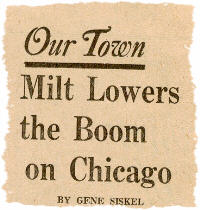BY GENE SISKEL WHEN Milt Ruttenberg was a little baby, sittin' on his mammy's knee, he picked a hammer and a piece of steel and said this hammer's gonna be the death of me, Lawd, Lawd, this hammer's gonna be the death of me. Like the fabled John Henry, Milt Ruttenberg, 5001 Madison st., Skokie, is a hard drivin' man. Milt is the head foreman for Speedway Wrecking company, one of the largest demolition contractors in the city. "We're not just destroying," says Milt, a rock hard, handsome man who happens to be a 55-year-old grandfather; and doesn't look a day over 40 ["see what the outdoor life can do for you"]. "We're just removing something that's obsolete and uneconomical. Now we can put something better can be put in its place." "After we get an address for a job I go out there and inspect the building. We look at the surrounding territory and the building itself. Based on the inspection, we decide what kind of people we're going to need and what equipment we'll use. No two jobs are ever the same. "I got a few torch men to take off the water towers and cut the steel, but for the most part we just started at the top and tore our way down." Just then a patrolman walked by. "Hey, Milt, when are you going to be, done? Monday? Say, let's kill a bottle of muscatel when you clean up." Naturally, in the wrecking business, as in everything else, times have changed. "Yes, in this job we started from the roof and tore down. We knocked it down, made a pile, the trucks come, you load em up, and they carry it away. "In the old days we used to tear things down by hand, build chutes, save any iron, lumber, and bricks. But with the shortage of skilled wreckers, the high wages, and the competitiveness in the world . . . " You mean,. . . "Yeah," he says with a grin, "you tear it down and get the hell out and over to the next job." Milt doesn't like the public's image of the wrecking profession. And when he looks at you with a pair of deep set, clear eyes, you aren't about to disagree. "The job, even swinging the ball into, the building, isn't as unscientific as it appears. It can't be taught. There aren't any schools that teach it," Milt began in the wrecking business in 1933. "I started carrying water for the work crews right after I finished high school. It's the only job I know. "My toughest job? Well, that'd have to be back in 1939 when we tore down the old Masonic temple at State and Randolph. it took us 57 working days to tear down that 23-story building. I don't think there has ever been a building that size ever taken down that fast." And what about the glamor? Do you still get a kick out of seeing all those walls come tumbling down? "Nope, it's just routine work now. When I was a kid, of course, it used to give me a big thrill. Right now the biggest challenge is to try to do something in the wrecking business that your competition is afraid to do. "You know there was a time when I didn't think I would be here. Back in '57, we were taking down the Pullman building at Michigan and Adams. I fell 85 feet down an elevator shaft and broke my neck, legs, and all my ribs" How does he feel to be envied by most every kid on the block? "It may appear glamorous, but it's not . . . it's not," and his eyes are on the ground. "But my four-year-old grandson," and now a big smile as he wipes his mouth "wants to be a crane operator. I told him never. But he has all these miniature construction toys, and I did give him a hard hat. "And whenever I come over to his home in Buffalo Grove, Mark asks, "When is grandpa going take me up in a big crane?" Milt is a native of Chicago. "All of us kids were raised in a three-story house at 1255 S. Morgan st. You know, I've never been back there. I wonder if it's still standing." Would you tear it down if you got the assignment?" "Sure." Would you swing your hammer a little harder? "Maybe." |
Greenberg Family Web Site Mark's Family Photos Milton Ruttenberg |


Gene Siskel was a reporter before he was a movie critic. This is the first interview that Gene Siskel did! (1969?) |



Mark and Papa Ruttenberg. Mark is probably around 3 (1968). |